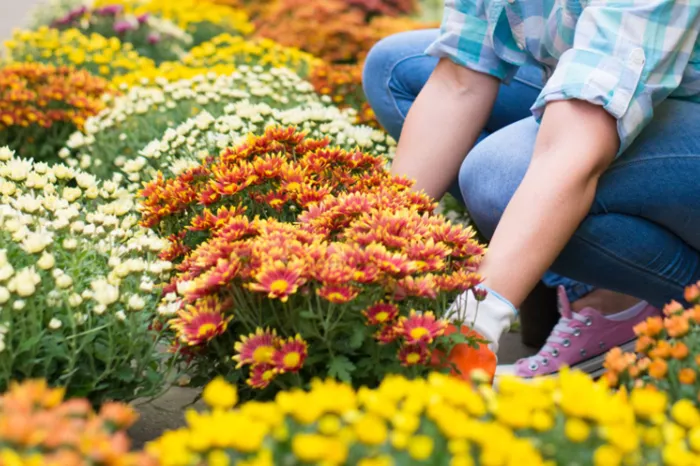Chrysanthemums, commonly known as mums, are a beloved choice for gardens. These herbaceous perennials belong to the Asteraceae (daisy) family and add vibrant color to fall landscapes. Mums typically grow in erect mounds that reach heights of 1 to 3 feet and widths of 1 to 2 feet. Symbolically, chrysanthemum flowers represent “cheerfulness, optimism, and abundance,” making them a popular choice for autumn displays.
A Historical Overview
Chrysanthemums have a rich history and a broad geographic presence. They were first cultivated in China as an herb, with references dating back to the 15th century B.C. By the 8th century, they had made their way to Japan, where their popularity soared. A single-flowered variety was even adopted as the crest of the Japanese emperor. In the 17th century, chrysanthemums were introduced to the Western world and received the name “Chrysanthemum,” which comes from Greek words meaning “golden flower.” Colonists later brought them to America, where they quickly became a favorite. There are over 160 species of chrysanthemums, primarily native to China, Japan, and Europe.
The Queen of Fall Flowers
The variety Chrysanthemum x morifolium is often hailed as the queen of fall flowers. These plants celebrate the season with jewel-toned blooms in yellow, lavender, pink, purple, red, bronze, orange, and white. Each flower comprises tiny components called florets. Bloom forms range from petite pincushions to large, spider-like flowers, offering countless options for gardeners.
Florist’s chrysanthemums (C. x grandiflorum) are the most recognizable autumn-blooming varieties, found in gardens, florist displays, and grocery stores. Known as garden mums, they come in a range of sizes, from under a foot tall to six feet, and feature diverse flower forms, sizes, and colors.
Variety of Flower Forms and Colors
Chrysanthemum flower forms include:
Anemone: Characterized by a large raised center and one or two rows of petals.
Decorative: Featuring broad, overlapping rays that form a full flower.
Pompom: A round, globular shape.
Spider or Quill: Long, tubular rays.
Other variations may exhibit fluted petals, curved rays, irregular petal lengths, and flattened tips. The colors available include red, pink, white, yellow, bronze, orange, purple, and multi-colored options.
Growing Chrysanthemums
Chrysanthemums are easy to cultivate. They thrive in relatively fertile soil, so adding compost before planting is beneficial. Regular watering is essential, but be careful to avoid soggy soil. Mulching around the plants helps maintain moisture levels. While mums prefer full sun, they benefit from some afternoon shade in warmer regions. It’s crucial to avoid planting them near street or night lights, as the blooms depend on longer nights (11 hours or more) to thrive.
To promote bushier growth, gardeners should pinch back new shoots when they reach several inches long. This practice should stop by early to mid-summer to allow buds to develop for fall blooms. For gardeners aiming for larger exhibition flowers, it’s recommended to disbud all but a few buds on each plant. Once flowering is complete, cut the stems back to about 8 inches.
When and How to Plant
Chrysanthemums can be planted in early spring or, in some areas, during the fall. While some types can be grown from seed, most are available as nursery plants or from mail-order catalogs. Since chrysanthemum plants need to be divided every few years, new starts can be obtained through division or rooted stem cuttings. Potted mums can be enjoyed indoors until their blooms finish, after which they can be cut back and planted outside for enjoyment the following year.
Conclusion
Chrysanthemums serve as beautiful garden borders and provide long-lasting blooms for both gardeners and florists. Their stunning colors make them a perfect addition to fall gardens. Consider adding chrysanthemums to your flower garden for a vibrant autumn display.
Related topics:
- Mums Shine as Summer Flowers Fade
- The Impact of Plants’ Airborne Signals on Defense Tactics
- Asters: The Perfect Way to Add Color to Your Autumn Garden


